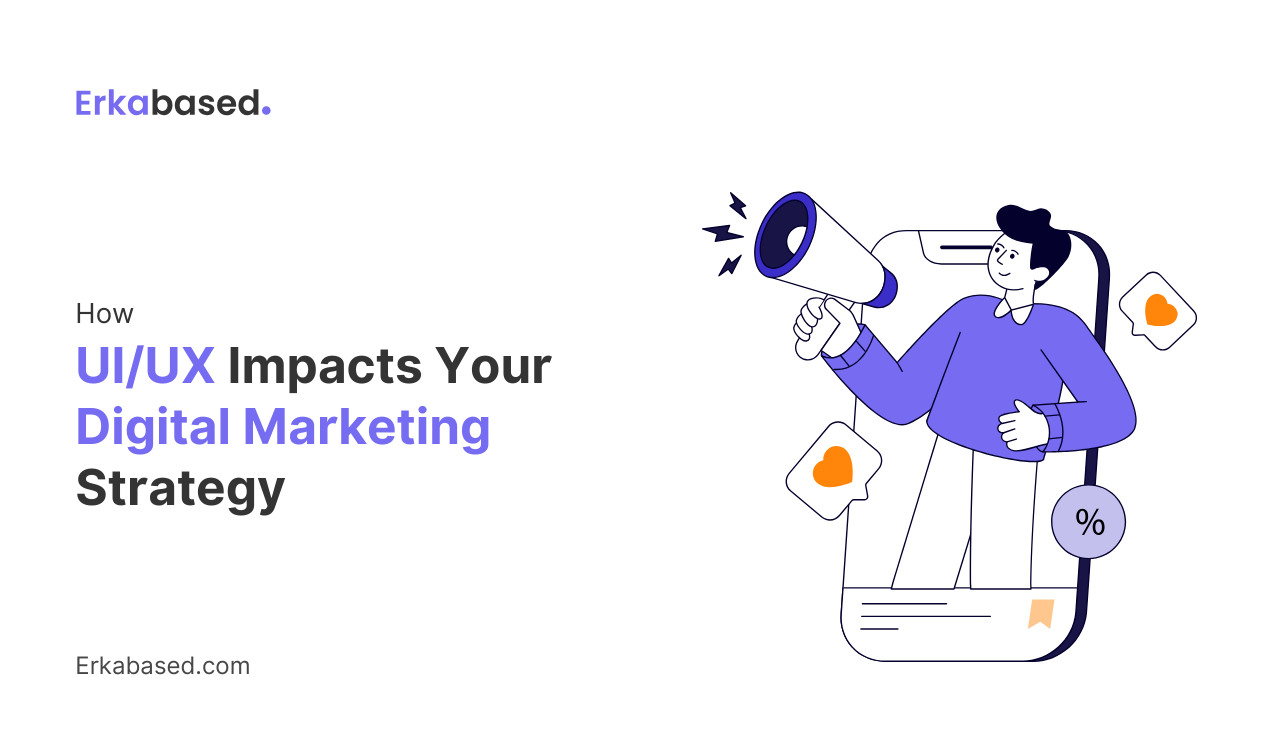Introduction
In today’s digital landscape, an effective marketing strategy goes beyond compelling content and eye-catching ads. At the core of every successful digital campaign lies a seamless user experience (UX) and a well-designed user interface (UI). The connection between UI/UX design and digital marketing is critical—how your audience interacts with your website, app, or online platform directly impacts your marketing efforts and business outcomes.
When done right, UI/UX can significantly enhance the effectiveness of your digital marketing strategy, driving conversions, customer satisfaction, and brand loyalty. In this article, we’ll explore how UI/UX design impacts digital marketing, why it’s a key part of business success, and how you can leverage it to optimize your marketing efforts.
The Role of UI/UX in Digital Marketing
Before diving into the impact of UI/UX on digital marketing, it’s important to understand what UI and UX mean in this context:
- User Interface (UI) refers to the design elements that users interact with directly—things like buttons, typography, color schemes, and layout. A clean, intuitive UI ensures that users can easily navigate your site or app, creating a visually pleasing experience.
- User Experience (UX) encompasses the overall experience users have when interacting with your digital platform. This includes everything from site speed and ease of navigation to the emotional response users feel when they engage with your brand.
When UI/UX is optimized, it fosters positive interactions that keep users engaged and encourage them to convert. On the other hand, poor design or a frustrating user experience can quickly turn visitors away, regardless of how good your product or content is. Let’s break down how UI/UX design plays a pivotal role in several key areas of digital marketing.
Enhancing Website Usability and User Engagement
One of the most immediate ways UI/UX impacts your digital marketing strategy is through website usability. The primary goal of any marketing campaign is to drive users to your website and convert them into customers. But if your website is difficult to navigate, slow to load, or confusing to use, visitors will leave before taking any action.
An intuitive UI helps users find what they are looking for quickly, while an optimized UX ensures that their journey through your website is smooth and logical. Elements such as easy-to-find menus, clear calls-to-action (CTAs), and fast loading times make a huge difference in how users perceive and interact with your brand.
A seamless experience not only keeps visitors on your site longer but also reduces bounce rates—leading to better engagement metrics, improved SEO performance, and higher conversion rates. In fact, studies have shown that improving UX design can increase conversion rates by up to 400%.
Key UX elements that drive engagement:
- Simple and intuitive navigation
- Consistent design elements across all pages
- Fast page loading times (preferably under 3 seconds)
- Responsive design optimized for mobile devices
Building Brand Trust and Credibility
Your website’s design is often the first point of contact for potential customers, and first impressions matter. A poorly designed or cluttered site can erode trust and make your business appear unprofessional. Conversely, a polished, well-thought-out design communicates professionalism, reliability, and attention to detail—all essential for building trust in your brand.
UI/UX design plays a key role in creating a visually consistent and trustworthy brand image. When users navigate a clean, aesthetically pleasing interface, they’re more likely to associate your brand with quality. Additionally, intuitive design helps users feel confident in interacting with your site, making them more likely to trust your products or services.
Ways UI/UX builds trust:
- Visual consistency in branding (colors, fonts, imagery)
- Clear, user-friendly interfaces that make navigation easy
- Thoughtful design choices that reflect professionalism
- Transparency in design (e.g., easy access to terms of service, privacy policy, etc.)
Incorporating these elements into your website design reinforces your brand’s credibility, which is crucial in an age where customers research online extensively before making purchasing decisions.
Optimizing for Mobile and Responsive Design
With more than half of all internet traffic coming from mobile devices, optimizing your UI/UX for mobile users is no longer optional—it’s a necessity. If your site isn’t optimized for mobile, you risk alienating a significant portion of your audience, which can severely hurt your digital marketing efforts.
A responsive design ensures that your website adapts to any screen size or device, providing users with a seamless experience whether they’re browsing on a desktop, tablet, or smartphone. Google also prioritizes mobile-friendly websites in its search rankings, meaning a poor mobile experience can impact your site’s visibility and SEO performance.
Ensuring a smooth mobile experience with easy-to-read content, fast load times, and intuitive touch interactions will not only enhance user satisfaction but also improve the effectiveness of your mobile marketing campaigns.
Key mobile UI/UX considerations:
- Touch-friendly navigation elements (e.g., larger buttons, simple menus)
- Responsive layouts that adapt to different screen sizes
- Minimalist design to reduce clutter on smaller screens
- Fast load times to accommodate slower mobile networks
Improving SEO Performance
Many businesses are surprised to learn that UI/UX design directly affects search engine optimization (SEO). Google and other search engines increasingly prioritize user experience as part of their ranking algorithms. A website that is difficult to navigate or takes too long to load will be penalized in search rankings, reducing the visibility of your digital marketing campaigns.
Optimized UI/UX design plays a vital role in on-page SEO. Factors such as mobile responsiveness, page speed, ease of navigation, and the overall structure of your website all contribute to how search engines rank your site. By focusing on improving the user experience, you can also boost your SEO performance, driving more organic traffic and enhancing the reach of your digital marketing efforts.
UX factors that improve SEO:
- Mobile-friendliness (responsive design)
- Fast loading speeds (under 3 seconds)
- Intuitive navigation that helps users find information quickly
- Lower bounce rates due to enhanced usability
In short, by enhancing your site’s UI/UX design, you not only create a better experience for users but also improve your SEO, increasing the likelihood that your content will be seen by a larger audience.
Boosting Conversion Rates
At the heart of every digital marketing strategy is the goal of turning visitors into customers. Whether your goal is lead generation, product purchases, or sign-ups, UI/UX design plays a direct role in driving conversions.
A well-designed user interface with clear, prominent calls-to-action (CTAs) can guide visitors toward taking specific actions. By removing friction points—such as confusing navigation, lengthy forms, or complicated checkout processes—you reduce barriers to conversion and encourage more users to complete the desired action.
For example, an e-commerce website that simplifies its checkout process with fewer steps, offers guest checkout options, and includes trust signals (e.g., security badges) is more likely to see higher conversion rates. Similarly, a lead generation site that clearly communicates the value proposition with a well-placed CTA will capture more qualified leads.
Best practices for conversion-boosting UX:
- Simplified, user-friendly forms
- Clear and compelling CTAs that guide users to action
- Minimal distractions on key conversion pages
- Fast and secure payment or sign-up processes
Creating a Seamless Omni-Channel Experience
In today’s digital world, customers interact with brands across multiple touchpoints, from social media and email campaigns to websites and mobile apps. Ensuring a consistent and seamless experience across all these channels is crucial for reinforcing your brand and improving user engagement.
UI/UX design helps create an omni-channel experience by ensuring that no matter where users interact with your brand, they encounter the same level of ease, design consistency, and functionality. Whether they’re browsing on your website, engaging with your social media pages, or using your mobile app, users should feel a cohesive experience that makes their journey frictionless and enjoyable.
For example, if a user adds a product to their cart via your mobile app and later completes the purchase on their desktop, the transition should be smooth and consistent. This seamless approach not only improves user satisfaction but also increases the likelihood of conversions, as users are less likely to abandon their journey when everything works harmoniously.
How to Integrate UI/UX Design into Your Digital Marketing Strategy
To fully leverage the power of UI/UX in your digital marketing efforts, you must integrate thoughtful design into every aspect of your strategy. Here’s how:
Conduct User Research Start by understanding your audience’s needs, behaviors, and pain points. User research helps you design experiences that resonate with your target market, ensuring that your UI/UX decisions are driven by actual user data.
Prioritize Mobile Optimization With mobile traffic dominating the web, ensure that your site is fully responsive and provides a seamless mobile experience. Prioritize touch-friendly elements, reduce load times, and streamline the user journey for mobile users.
Optimize Your CTAs Ensure that calls-to-action are prominent, clear, and compelling. Whether it’s a “Buy Now” button or a “Sign Up” form, guide users toward the actions you want them to take with clear, engaging CTAs.
Test and Iterate UI/UX design should be continuously refined through A/B testing and user feedback. Test different design elements, layouts, and interactions to see what resonates most with your audience. Use data-driven insights to optimize and improve the user experience.
Conclusion
Incorporating thoughtful UI/UX design into your digital marketing strategy isn’t just about making your website look good—it’s about creating a seamless, intuitive experience that enhances user engagement, builds trust, and drives conversions. In a competitive digital landscape, businesses that prioritize user experience are better positioned to achieve long-term success.
At Erkabased, we specialize in developing custom digital solutions that integrate exceptional UI/UX design with data-driven marketing strategies. Our team of experts is here to help you optimize your digital presence and create experiences that delight your users while driving measurable business results. Contact Erkabased today to learn how we can help you take your digital marketing strategy to the next level with the power of UI/UX design.






